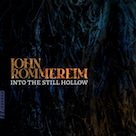

John Rommereim: Into the Still Hollow
Navona
Records
A man of multiple talents, John Rommereim is a composer, choir conductor, harpsichordist, and pedagogue who's distinguished himself as an admired creator of both vocal and instrumental music. Both sides are captured on this superb chamber music compendium, which extends from lieder arranged for vocalist and, respectively, piano and string quartet to settings for solo guitar and duos of organ and saxophone and organ and oboe. Interestingly, rather than an expected alternation between vocal and instrumental works, the sequencing of the release bifurcates the two, with five vocal settings followed by three instrumental ones.
In Rommereim's vocal writing, the text guides the compositional choices, his intent being to craft expressive music that captures the emotional essence of the words. That's splendidly exemplified in the collection's titular work, whose three parts are set to texts by W. S. Merwin. Rommereim, who when not composing or performing is Blanche Johnson Professor of Music at Grinnell College, draws upon a vast range of experience for his compositions, with writing for the theatre and film also parts of his background. In this particular set, inspiration for some of the writing comes from Schubert and Beethoven, the connection to the former emerging in the central part of Into the Still Hollow and the latter referenced in the title Gesangvoll: Variations on a Theme by Beethoven.
As always, a composer needs great interpreters, and to that end Into the Still Hollow boasts stellar contributions from baritone Thomas Meglioranza and soprano Charlotte Mundy, who respectively partner with pianist Reiko Uchida and Sirius String Quartet, and on the instrumental pieces guitarist David William Ross, organist Karel Martinek, saxophonist Pavel Zlámal, and oboist Jan Kucera. Meglioranza and Uchida are dominant presences on the album as they deliver four of the eight works.
Recorded at various locales between 2021 and 2024, the album begins with the two performing Into the Still Hollow, its striking opening movement marked by a procession of individuals who provide brief summaries of their lives and then withdraw into death after concluding their narratives with the Latin phrase, “Quod, ecce, nunc in pulvere dormio” (“And behold, I now sleep in the dust”). Meglioranza and Uchida distinguish Rommereim's music with performances thoughtfully attuned to the texts (hear, for example, her scampering across the keyboard during the “mouse” section in the Scholar's passage) and exuding clarity, refinement, and dignity. Their handling of pacing and dynamics is noteworthy too. Described by the composer as “aspir[ing] to be in conversation with “Der Lindenbaum” from Schubert's Winterreise,” the tender “Elegy for a Walnut Tree” finds the poet contemplating how his life has developed in tandem with a beloved tree (“… all these years I have looked through your limbs … and you were the way I saw the world”). “For the Anniversary of My Death” concludes the work with the wry recognition of human fallibility and the gaining of hard-fought wisdom.
The single-movement Time and Wind introduces a dramatic shift in texture when the terrific Mundy performs with Sirius String Quartet. Tonally, however, the inward-probing nature of the piece, its text comprised of fragments from the first chapter of Joyce's Ulysses, perpetuates the reflective character of “For the Anniversary of My Death.” The stream-of-consciousness quality of the words aligns splendidly to entrancing music that feels suspended in time. Subsequent to it three songs featuring Meglioranza and Uchida appear, “The Gift,” “Rings of Birchbark,” and “It Nests Within Each Cell” set to words by, in turn, Louise Glück, A. R. Ammons, and May Swenson. The first charms with its playful evocation of a child's wonder during initial engagements with the world, the second philosophically reflects on death and the traces of ourselves that persist after we're gone, and the delicate third, written for a wedding occasion, ruminates, naturally, on love, casting it as a “sheath to keep us pure of fear.”
A trio of instrumental performances comes next, the first, Upon the Blue Guitar, a three-movement work performed dazzlingly by classical guitarist Ross and inspired by the the Wallace Stevens poem “The Man With the Blue Guitar.” Ross hews closely to the material as written but nevertheless imposes his stamp on it through the beauty and sheer enthusiasm of his playing. Prelude on “Lauda Anima” sees saxophonist Zlámal and organist Martinek dueting on a majestic, chorale-styled rendering of a familiar hymn tune, after which the organist partners with oboist Kucera on Gesangvoll: Variations on a Theme by Beethoven, the third movement of his thirtieth piano sonata the springboard for Rommereim's treatment. The coupling of oboe and organ proves mellifluous, especially when Martinek complements the oboe's distinctive timbre with the oboe stop on his instrument. Into the Still Hollow is, in essence, a portrait album of Rommereim in the way it includes accounts of his vocal and instrumental work. In that regard it offers a splendid sampling of his gifts and flatters both him and the interpreters whose talents were drawn upon for the project. As portraits go, it's a particularly fine one.April 2025